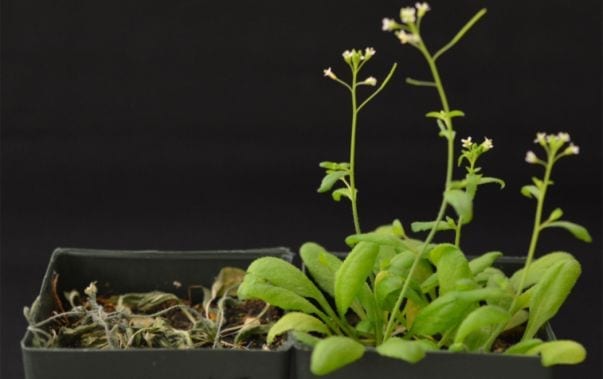
UC Riverside-led research in synthetic biology provides a strategy that has reprogrammed plants to consume less water after they are exposed to an agrochemical, opening new doors for crop improvement
Crops and other plants are constantly faced with adverse environmental conditions, such as rising temperatures (2014 was the warmest year on record) and lessening fresh water supplies, which lower yield and cost farmers billions of dollars annually.
Drought is a major environmental stress factor affecting plant growth and development. When plants encounter drought, they naturally produce abscisic acid (ABA), a stress hormone that inhibits plant growth and reduces water consumption. Specifically, the hormone turns on a receptor (special protein) in plants when it binds to the receptor like a hand fitting into a glove, resulting in beneficial changes – such as the closing of guard cells on leaves, called stomata, to reduce water loss – that help the plants survive.
While it is true that crops could be sprayed with ABA to assist their survival during drought, ABA is costly to make, rapidly inactivated inside plant cells and light-sensitive, and has therefore failed to find much direct use in agriculture. Several research groups are working to develop synthetic ABA mimics to modulate drought tolerance, but once discovered these mimics are expected to face lengthy and costly development processes.
The agrochemical mandipropamid, however, is already widely used in agricultural production to control late blight of fruit and vegetable crops. Could drought-threatened crops be engineered to respond to mandipropamid as if it were ABA, and thus enhance their survival during drought?
Yes, according to a team of scientists, led by Sean Cutler at the University of California, Riverside.
The researchers worked with Arabidopsis, a model plant used widely in plant biology labs, and the tomato plant. In the lab, they used synthetic biological methods to develop a new version of these plants’ abscisic acid receptors, engineered to be activated by mandipropamid instead of ABA. The researchers showed that when the reprogrammed plants were sprayed with mandipropamid, the plants effectively survived drought conditions by turning on the abscisic acid pathway, which closed the stomata on their leaves to prevent water loss.
The finding illustrates the power of synthetic biological approaches for manipulating crops and opens new doors for crop improvement that could benefit a growing world population.
Read more: Scientists Reprogram Plants for Drought Tolerance
The Latest on: Reprogramming plants
[google_news title=”” keyword=”Reprogramming plants” num_posts=”10″ blurb_length=”0″ show_thumb=”left”]
via Google News
The Latest on: Reprogramming plants
- 12 DC villains who are better than most DC heroeson April 25, 2024 at 10:33 pm
Leslie Willis, aka Livewire, tried to pull off the ultimate prank by reprogramming Metropolis' power grid to ... green costume that left little to the imagination. With her hypnotic plant toxins to ...
- Why I Upgraded to a Smart Sprinkler Controller ( and You Should Too! )on April 25, 2024 at 3:45 pm
Ever found yourself staring at your soggy lawn, or worse – dead lawn, wondering if there’s a better way to manage your sprinkler system without having to adjust it every season? I’ve been there, and ...
- Everything You Need to Know About Cassandra Nova, Deadpool & Wolverine’s Surprising X-Villainon April 25, 2024 at 11:45 am
Deadpool & Wolverine’s new trailer yesterday didn’t really give fresh details on what the film’s going to be about, beyond the vague threat of multiversal shenanigans and Wade and Logan’s team-up. But ...
- Doctors Combined a Heart Pump and Pig Kidney Transplant in Breakthrough Surgeryon April 24, 2024 at 8:07 am
In the first procedure of its kind, a 54-year-old New Jersey woman received a genetically engineered pig kidney and thymus after getting a heart pump.
- Why cobots hold the key to unlocking operational efficiency in large manufacturerson April 24, 2024 at 6:37 am
The president of Teradyne's robotics group, Ujjwal Kumar, discusses the benefits of cobots for small to large manufacturers.
- Caring Cross and Fiocruz Partner for Low-Cost CAR-T Manufacturing in Brazilon April 17, 2024 at 1:01 pm
Caring Cross will help Brazil’s Fiocruz establish CAR-T cell therapy production capacity under new partnership.
- Computer model suggests frozen cells could be used to save northern white rhino from extinctionon April 17, 2024 at 7:39 am
A team of geneticists and computer scientists from the San Diego Zoo Wildlife Alliance, Cornell University and the University of California, Santa Cruz, has created a computer model that shows it ...
- Stroller: Budget, submarine and dog talkon April 15, 2024 at 9:30 pm
Although the editorial had characterized the mayor’s failure to disclose the details of the meeting as a lapse that could not be expiated, many of ...
- GM Releases Fix For 2024 Chevy Silverado HD Duramax Selective Catalyst Reduction Faulton April 15, 2024 at 12:03 am
General Motors has released a service update for units of the 2024 Chevy Silverado HD equipped with the 6.6L V8 L5P turbodiesel Duramax engine.
- Dr. Pescatore’s Logical Health Alternatives Reviews: Can You Trust Customer Results?on April 12, 2024 at 1:30 am
Dr. Pescatore and his team at NewMarket Health Publishing have launched a new promotional campaign for Logical Health Alternatives, his health information subscription program.
via Bing News










